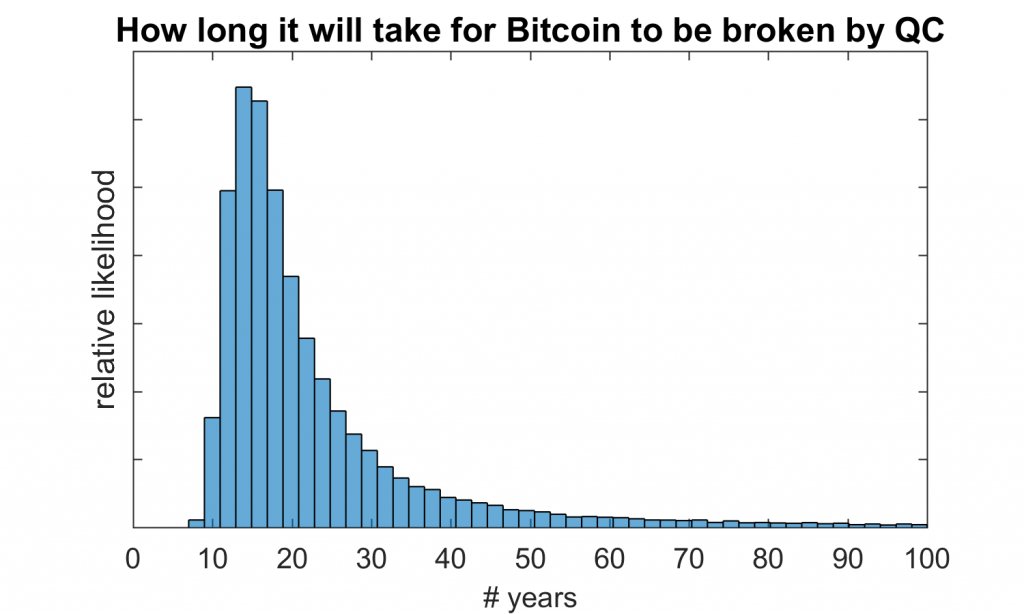With the more and more frequent news about record-breaking quantum computers, some believe that Blockchain may soon be a thing of the past.
In this article, we’ll try to find out if, or to what extent, does quantum computing pose a threat to distributed ledgers and blockchains. Is it true that soon the most cryptographically secure way of storing data will be broken? Can something be done about this quantum threat? Is it even a threat at all?
We will explain what quantum computing is, and why some argue that it may spell the end of distributed ledgers as we know it. We will also take a look at some of the solutions already on the market, and determine whether quantum computing is something to be ignored completely, whether you should start selling your crypto-portfolio right this second, or if, perhaps, the answer lies somewhere in between.
| At eToro you can trade 49 currency pairs, including several cryptocurrencies. Join eToro |
What is quantum computing?
Today’s computers’ smallest element is a bit, which can take the value of either a 0 or 1. Quantum computers aren’t limited to only these two options. Their elements can exist in a so-called superposition, which means that they can assume several states at once, allowing them to be much more powerful than contemporary solutions.
 However, the state of superposition is extremely unstable, and anything can change it, from electromagnetic fields to mechanical vibrations, thermal noise, etc. Because quantum computers are so sensitive to changes in the environment, they are very hard to maintain and manage. There is a trade-off between computational power and stability – if you want to have more computational power, add more elements, but the more elements you add, the less stable the environment becomes. This is the main challenge within quantum computing.
However, the state of superposition is extremely unstable, and anything can change it, from electromagnetic fields to mechanical vibrations, thermal noise, etc. Because quantum computers are so sensitive to changes in the environment, they are very hard to maintain and manage. There is a trade-off between computational power and stability – if you want to have more computational power, add more elements, but the more elements you add, the less stable the environment becomes. This is the main challenge within quantum computing.
Quantum computer elements are called quantum bits, or qubits.
Adding a few qubits may seem small, but it leads to an exponential growth in processing power. According to Technology Review’s qubit counter, the latest advancement happened last year, reaching 128 qubits by Rigetti.
Quantum computing is already being used in a variety of sectors, including IT, automobiles, air travel, and pharmacy.
Although basic quantum computers capable of certain calculations have been built, the general consensus among the scientific community is that a true quantum computer is still years away.
Quantum computing on the rise
In October this year, Google AI, the division of Google focused solely on artificial intelligence, has announced that together with NASA (U.S. National Aeronautics and Space Administration) their Sycamore quantum processor has completed a task in 200 seconds that would have taken a state-of-the-art supercomputer around 10,000 years to finish.
Even more recently, in December 2019, Amazon’s cloud computing division, Amazon Web Services (AWS), rolled out Amazon Braket, where clients can explore and experiment with quantum computing by either designing a quantum algorithm from scratch or choosing one of the pre-built ones. Amazon was not the first to offer early-stage quantum computing services over the cloud to its clients. IBM has been doing it since 2016.
Why does quantum computing pose a danger to blockchains?
The logic is that quantum computing could be a danger to blockchains because of the threat to encryption. Currently used encryption methods transform information, like data and passwords, into long strings of numbers, which would take potential attackers years to break with brute force (i.e. using computer power to guess every possible solution). However, quantum computers would be able to calculate in seconds what normal computers, including supercomputers, would need years to break.
Is Bitcoin vulnerable to a quantum attack?
Many cryptocurrencies, including Bitcoin and Ethereum, use the Elliptic Curve Digital Signature Algorithm (ECDSA) to ensure that funds are spent only by their rightful owners. However, this form of generating digital signatures has been found to be vulnerable to quantum attacks, which means that a quantum computer could break it. And although there is no quantum computer nearly powerful enough to do that now, it is a question of “when” and not “if”.
If the developments in quantum computing are gradual and public, nodes could switch from the vulnerable ECDSA and implement a quantum-resistant signature scheme. Users would then need to transfer their balances from an address based on the old algorithm into an address that is safe from a quantum attack. But a far worse situation could happen if quantum computing were to advance suddenly and an attack would occur. As Bitcoin’s price relies on people’s trust in the system, such an attack could have a devastating effect on Bitcoin’s price and trust in the whole cryptocurrency market.
Quantum-resistant blockchains
If you are worried that blockchains will soon be broken, don’t. Some experts within the field of distributed ledgers and blockchains have noticed the potential threat of quantum computing, and have started to work on solutions. Here are a few blockchains and distributed ledger projects declaring to be resistant to quantum attacks.
 The Quantum Resistant Ledger
The Quantum Resistant Ledger
The Quantum Resistant Ledger, or the QRL, is one of the most popular DLT solutions for the quantum threat.
QRL implements XMSS (Extended Merkle Signature Scheme), which is a hash-based provably forward secure (in case of a key compromise, the keys created earlier remain valid) signature scheme. It works by wrapping Winternitz One Time Signatures (WOTS+) (hashes) in Merkle trees, allowing for reusable addresses. The utilization of WOTS+ and XMSS (currently in the process of being approved as quantum-resistant by the NIST) is what will make the QRL quantum-resistant. For now, hashes are still the way security vulnerabilities present in ECDSA are avoided.
QRL is currently a PoW chain, but the team is actively working on developing a PoS/Hybrid PoS solution.
The QRL solution has been verified by two separate audits and their signature scheme, XMSS, is expected to soon receive approval for usage by the National Institute of Standards and Technology (NIST) of the U.S. Department of Commerce. So shortly QRL may be the sole crypto-asset applying NIST-approved post-quantum cryptography.
Praxxis
 Praxxis is a cryptocurrency based on a quantum-resistant blockchain. It is a very new project, announced towards the end of summer 2019. It aims to bring what’s currently needed in this area: decentralisation, speed, privacy, and scalability, while at the same time providing security against the approaching quantum threat. The quantum security is done thanks to a new consensus algorithm, called xxBFT or xx consensus, which is also said to have low energy consumption.
Praxxis is a cryptocurrency based on a quantum-resistant blockchain. It is a very new project, announced towards the end of summer 2019. It aims to bring what’s currently needed in this area: decentralisation, speed, privacy, and scalability, while at the same time providing security against the approaching quantum threat. The quantum security is done thanks to a new consensus algorithm, called xxBFT or xx consensus, which is also said to have low energy consumption.

Praxxis has been founded by David Chaum, famous cryptographer and expert in privacy-preserving technologies, who is currently CEO. Chaum is certainly a name you should be familiar with. His work in the 80s and 90s was extremely important to the fields of cryptography, anonymous communication, and even blockchain (his dissertation suggests a protocol extremely similar to what we call a blockchain today). He is considered to be the inventor of digital cash (DigiCash from 1995). Besides Praxxis, Chaum is currently involved in Elixxir, a privacy platform that enables digital sovereignty. Certainly, having a person so involved and well-known in the blockchain circles speaks volumes about this cryptocurrency.
On the other hand, besides stating that they apply “distinctive cryptography which is fundamentally different from that promulgated by the government and which is strongly resistant even to quantum-level attack”, the Praxxis team is really light on the details on how exactly they achieve quantum resistance.
So is quantum computing a threat to Blockchain?
Despite the fact that it may seem like soon Blockchain may be a thing of the past due to the threat of quantum computing, it seems that there is little to worry about. Now and for the foreseeable future. Remember that Google claim that their quantum computer finished a calculation in 200 seconds that would have taken the fastest computer 10,000 years? Well, this has been challenged by IBM, who said that instead of 10,000 years like Google claimed, the task could be done in… 2.5 days.
Moreover, that quantum computer had 53 qubits but breaking cryptocurrencies would require nothing less than 1500 qubits, and that is still years away. Some say that the current Bitcoin 250-bit ECDSA keys should be safe until 2030-2040 at least, possibly even longer.

It is good that some blockchain experts have started to think about quantum computing and what it may mean to Blockchain, but in reality, all blockchains are already quantum-resistant (hash-based cryptography employed in blockchains is resistant to the quantum threat given a sufficiently long key size), and will remain so for years to come.
Quite possibly, blockchains, as we know them, will not go away, but rather evolve and employ new quantum-resistant signature schemes like the examples of Praxxis and the QRL. As more and more companies will come out claiming to be quantum-resistant, it might be useful to distinguish between those marketing the hype and those that really propose a quantum-resistant solution. Here are a few tips on how to spot the legit ones.
| At eToro you can trade 49 currency pairs, including several cryptocurrencies. Join eToro |











